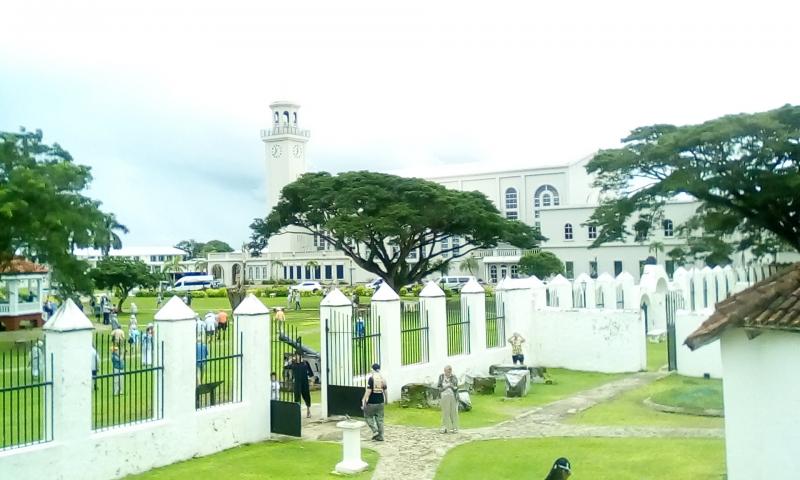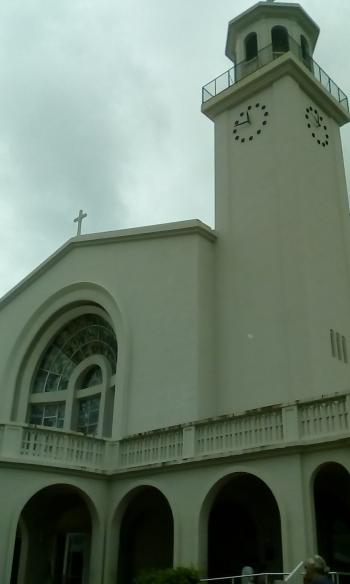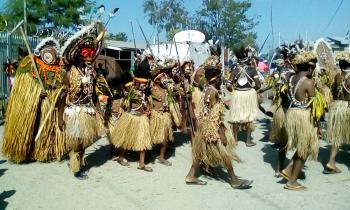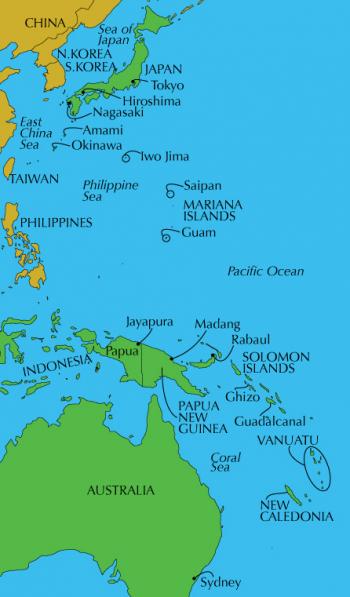Exploring the legends of the Pacific by ship
This article appears on page 19 of the October 2020 issue.
What could be better than combining two dream destinations into one trip? I had always wanted to visit World War II sites in the Pacific, and Papua New Guinea had been on my country “to do” list for a long time. I discovered that Holland America Line’s “Legends of the Pacific” cruise, aboard the Maasdam, offered both, with the convenience of sailing easily from one destination to another.
Making plans
As usual, I selected a solo cabin, making the cost of the voyage (Aug. 28-Sept. 26, 2019), including the single supplement, $5,248. In addition, I added a single night in Tokyo before the cruise. A night at the Keio Plaza Hotel (www.keioplaza.com), which included a transfer to the ship the next day, cost an additional $548.
I booked my air with Holland America (877/932-4259, www.hollandamerica.com) as well, which included transfers from the airport to the hotel in Tokyo and from the ship to the airport in Sydney at the end of the cruise. The total cost for air from Cleveland, Ohio, and transfers was $1,380, and taxes and port charges added another $644, for an all-in cost of $7,820.
For me, the cost for such a long trip and unusual itinerary was very reasonable. It’s important to note, however, that nothing else was included. Shore excursions could easily add another $1,000 or more to the total package, and wine with meals or dining in the two prestige restaurants on board were also extra, as were soft drinks and pretty much everything else. Still, I felt the cruise was a bargain.
After my 12-hour flight to Tokyo, I was glad to see the transfer agent waiting with my name on a card. The ride to the hotel took almost two hours — something I could never have negotiated on my own.
The Keio Plaza was a modern, comfortable hotel; all the staff spoke excellent English, and WiFi was free. Though breakfast was not included, I managed well enough with the in-room coffee maker and some granola bars from home.
Holland America provided a welcome letter in the room explaining the transfer details for the next day.
After a quick transfer to the port in the morning, I got settled in my cabin on the Maasdam, which had a king-sized bed, a small desk, closets, a small sofa and a TV. Reception was limited, of course, but I at least got a couple of news channels and a few others as well as the in-house movies.
Our first day was at sea, allowing for a welcome rest after the long flight from the States.
Historical stops
The ship’s first stop was Hiroshima, which I had visited on an earlier trip. Six excursions were offered there, but I chose to stay on board.
However, at our next stop, Nagasaki, I booked the 4-hour “Nagasaki History & Culture” excursion. Our guide, a retired English teacher in her 70s, led us knowledgeably through the Atomic Bomb Museum, containing information about the second atomic bomb, dropped on Aug. 9, 1945. Though much less extensive and less modern than the museum in Hiroshima, this one presented sobering videos of the blast that had been filmed from the plane, as well as artifacts such as fused soda bottles and a child’s lunch box with incinerated contents, and photos of the physical damage endured by those who were in harm’s way.
We then visited the Nagasaki Peace Park, overseen by a statue of a man pointing upward toward impending doom and forward to the hope of peace in the future. Throughout the park, statues donated by many countries testified to the often-stated hope for peace.
Our last stop was the Museum of History and Culture, which recounted the city’s history from the time it was the only access point for entry to Japan by Western traders. Displays included a magistrate’s office and typical trade goods. The experience was frustrating, however, as there was little explanatory text in English.
Onboard activities
Because of the great distances we traveled and the necessary at-sea days, the ship supplied plenty to fill the time, including games, yoga and sports (pickleball, basketball, ping-pong) as well as movies and lectures, mostly related to the itinerary.
One of the first lectures discussed the history leading up to World War II, while other lectures dealt with the natural history of the various destinations on our schedule, focusing especially on birds.
The series of lectures on astronomy, however, seemed pointless to me. Why lecture on the Chesapeake Bay impact crater when we are touring the South Pacific? The lectures themselves were good but totally unrelated to our trip.
Additionally, there was almost nothing said by anyone about the ethnography of the various island groups. I would have liked to know about the history of the various peoples and their languages.
For the most part, I spent my days exercising and reading when not off on an excursion. Holland America caters to an older set, and this trip, geared as it was to World War II history, certainly appealed to those for whom there was a close connection with the war. (My stepfather served with the Marines in the Pacific.)
A true irritant for me was the onboard casino, where smoking was allowed. But the smoke obviously didn’t stay there. There were no doors separating the casino from adjacent areas, like the reading areas and even the stairwell, so they were polluted after a short time.
Weather watch
Our next stop after Nagasaki was Amami (Naze), where I elected just to walk around by myself rather than go on a tour. The small town sent a welcoming committee to greet us and also set up a market on the dock to facilitate shopping. One young greeter asked passengers where they were from, how they liked Japan and so on, and another translated our responses into Japanese for bystanders.
Our stop in Naha (Okinawa) was a brief one, since oncoming Typhoon Lingling forced us to depart after refueling. The captain announced that 35-foot waves were anticipated in the harbor and that all excursions would unfortunately be canceled. The weather map posted on the video screens in the ship’s public areas showed us barely scooting out of the way of the high winds.
In fact, we ducked or outran three storms over the course of the cruise and often had 30-knot winds boosting us along.
Though we couldn’t land on Iwo Jima, we sailed around the island accompanied by a lecturer who explained the details of the battle there in February-March 1945. We later watched a 2001 documentary, “Iwo Jima: Memories in the Sand,” which captured the return to Iwo Jima by veterans from both sides of the conflict. Around 21,000 Japanese were killed and 7,000 Americans during this 5-week battle for a tiny scrap of land 8 square miles in size.
After a sea day, we arrived in Saipan, in the Northern Mariana Islands, where I chose a tour of the south part of the island. We visited the old Japanese jail where Amelia Earhart is said to have been held captive, then Red Beach, where the 2nd Marine Division landed in 1944, and finally Blue Beach, where we saw Sherman tanks still in the water where they had fallen off the pontoons that transported them from larger ships.
Tourism is Saipan’s main industry now, and one of the gateways to get there is Guam, where we soon were headed.
Along with Saipan, Guam is actually part of the United States and boasts US military bases. I opted for a visit to the Asan Bay Overlook, part of the War in the Pacific National Historical Park.
We had almost no time to see the exhibits in the park’s visitor center, but we did visit the Latte Stone Park, where we saw the remains of village huts in the form of huge coral pillars resembling fat-stemmed wine glasses. The shape is an icon of the Chamorro people, who constructed such pillars as foundations for their huts.
On to PNG
Our next stop, Jayapura, Indonesia, had to be canceled for safety reasons. Protests and riots made docking and touring questionable. Though the Captain cast around for alternatives, none was possible, so we enjoyed another at-sea day on our way to Papua New Guinea.
Papua New Guinea had been on my “to do” list for years, so our three stops on this island were the fulfillment of a long-held wish. I wasn’t disappointed!
Most visitors to PNG go for nature and wildlife tours, especially along the Sepik River and in the Highlands. I got the impression as we docked and disembarked in Wewak, a small town of about 25,000 inhabitants, that the locals rarely see such a large ship or so many people at once.
Small, apparently handmade outrigger canoes surrounded the ship, the paddlers waving furiously at us. When we went ashore, dancers, hawkers and just about everyone in town, it seemed, lined our path to greet us.
As we drove to various sites, people on both sides of the road waved, held up children and threw leaves at us. I felt like a rock star!
I selected the 2-hour “Wewak Highlights & Market” tour, which started on Mission Hill, a memorial to WWII soldiers and the site of Japanese gun mounts. Again, there were locals everywhere, and we stopped to chat with people and take pictures.
We then drove down to visit the local school. As it happened, it was Friday, and Monday was PNG’s national day, like the 4th of July in the US. The kids had just listened to the principal speak, who then sent them off for a week’s holiday.
While the older kids stayed inside, the younger ones clustered around us, excited by meeting so many visitors. They spoke excellent English — and with an American accent, which surprised me. We talked about this and that, and they posed for the camera.
Madang and Rabaul
We pressed on to Madang, where our visit was a study in confusion. I chose the Madang Festival excursion, which was represented as being a cultural highlights experience at a lovely resort. Our bus from the ship dropped us off at the gate to the resort, where we were told that the performances were not to take place for another hour.
There were only a few stalls selling tourist goods around the gate area and no way to fill the time, but someone soon came to the gate and invited us to wait inside for the hour.
There were groups of dancers scattered over the resort grounds, and we assumed that a performance would start in front of us within the hour, though we were told nothing.
Finally, a woman from the ship (not a staff person) said that we were supposed to be going from one group of dancers to the next. There was no one, neither from the shore excursion office nor from the local tourist company, to explain what was going on or what we were seeing, so I decided to return to the ship. The tour announced to last four hours became a 2-hour waste of time.
In part to make up for our two missed ports of call, the ship provided a scenic cruise of Garove, a caldera in the Vitu Islands group. At 3 miles across, the caldera was a reminder that we were on the Pacific Ring of Fire, where volcanic activity is a part of everyday life. In fact, what I first took to be smoke from a stove or fire in the hills turned out to be venting from the volcano below.
In contrast to Madang, our visit to Rabaul the next day was excellent. I opted for the “Volcanic Tour,” where we ascended Tovanumbatir, one of the sub-vents of the active Rabaul volcano. On the way, our very capable guide explained the sites that had once been occupied but now were under 10 feet of ash after the 1994 eruption of Tavurvur.
Because of the Rabaul Volcanological Observatory, the island had about 19 hours of notice before the 1994 eruption, so the authorities managed to evacuate almost everyone. At the observatory, we watched the meters and dials and printouts that record every burp of the volcanoes daily.
It’s hard to imagine living in the shadow of such a threat, but people seem to be able to adjust to anything!
The Solomon Islands
At Ghizo Island (Solomon Islands), there was an opportunity to learn more about the local culture, so I selected the “Saeragi Cultural Village” tour. One of the alternatives was a visit to the island to which John F. Kennedy swam after PT-109 was struck and sunk by a Japanese warship in 1943. It was a tough choice.
Due to high swells, boarding the tenders that would take us ashore was difficult. We arrived at the dock of Gizo about an hour behind schedule, but the market was in full swing and the town busy with activity. From there, the group boarded a small motorized boat for the 40-minute trip to the opposite end of the island, where we sat along the beach for a “traditional” warrior dance performance. I doubt there was anything traditional about it, but it was fun!
We then wandered around the island, admiring the houses on stilts, drinking coconut milk and eating sweet potatoes and cassava baked in a stone pile. Particularly delicious was a ground-nut mixture steamed in banana palm leaves.
Some visitors spent their time swimming or lying on the beach, but after a couple of hours I decided to go back to see what was happening in the island’s capital, Gizo.
This was one of the more expensive excursions, at $136; most were between $80 and $200, and they do add up.
Movies were offered daily on board in the Wajang Theatre, complete with popcorn. After my return, I watched “The Thin Red Line,” a 1964 film about the Battle of Guadalcanal in the Solomon Islands. My excursion the next day took us to the real thing.
There were two premium restaurants on board, Canaletto ($19) and the Pinnacle Grill ($40). My travel agent gave me an evening in each along with a wine card as a token of our 14-year relationship, but, as a vegetarian, I didn’t find the food any better than that in the Rotterdam dining room or the informal Lido Restaurant, and the atmosphere in each wasn’t different enough to warrant the extra cost.
Heading toward Australia
Our final stop was New Caledonia, which I had visited once before. I had planned to see the Museum of New Caledonia in Nouméa, on the main island of Grande Terre, to see the collection of Kanak and Oceanic art, one of the finest in the world according to its website. Several of us walked about a mile or so up to the museum only to find that it was closed for two years for renovation! Nothing on its website warned about that.
I wandered around town for a bit, but because it was Sunday, most things were closed, so I headed back to the ship, disappointed not to have signed up for an excursion.
Sydney, Australia, was our final destination and, for me, the departure point for home. Before this South Pacific trip, I and my travel agent each contacted Holland America by phone and were both told that no visa was required for any destination on this cruise, but I found this not to be true. A visa (for Americans, an ETA, or Electronic Travel Authority) was required to enter Australia, which my travel agent arranged for me. It’s best to contact the State Department for accurate information.
After a long flight home, I settled in to savor my experience. Nothing is perfect, but, overall, I felt that the “Legends of the Pacific” cruise aboard the Maasdam was a bargain. Considering the exceptional itinerary and the overall quality of the food and service and most of the excursions, it’s a trip I would recommend to anyone.
** Editors note : In an earlier version of this article, the first photo titled "Guam's Plaza de España" was incorrectly titled "Saipan's Plaza de España."




